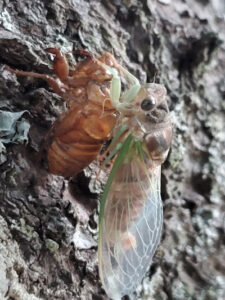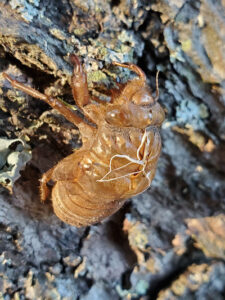August 13: A Creature from a Horror Movie

Recently molted cicada drying wings
It started with my daughter yelling “Come quick, there’s a half-dead animal stuck to a tree!” A statement like that always gets me moving. My mind flashed to my time out west, where deer carcasses hung from tree branches, stashed by mountain lions for later meals. I was somewhat relieved to discover that the “half-dead animal stuck to a tree” was much smaller and very alive, even though it did resemble a creature from a horror movie. It turns out my daughter had discovered an insect called a cicada in the process of molting from a nymph to an adult.
Most people do not get to see a cicada molt, as the whole process is over within an hour. The entire lifecycle is difficult to view, as cicadas spend most of their time in the top of trees or underground among tree roots. It begins with midsummer mating, after which the female cuts a slit in a twig and lays her eggs. In about six weeks the eggs hatch and the small nymphs drop to the ground and burrow into the soil. Cicadas spend the majority of their lives as nymphs living underground, digging chambers near roots for feeding.
When midsummer rolls around once again, these underground cicada nymphs construct an exit tunnel and emerge on the surface. They climb a few inches up a tree trunk, clinging strongly to the bark, and molt. Molting is the final stage in the cicada lifecycle, in which the nymph transforms into an adult and gains flight and the urge to reproduce. During molting, the cicada’s back splits down the middle, cracks open, and the adult wiggles out. It clings to its old exoskeleton as it squirms and plumps up its soft new wings. Once dry, the cicada flies to the top of the tree for safety and to find a mate.

Cicada exuvia on a tree
It’s the infamous noise cicadas make when looking for a mate that we are most familiar with. Some folks find the calls maddening, as they work in large numbers to create a sharp buzzing noise that can rise and fall in both pitch and volume. It’s only the males that make the sound, not only to serenade potential mates, but also to indicate distress. Male cicadas have two membranes called tymbals on their abdomens, which are mostly hollow and naturally amplify the clicks produced as they vibrate.
The cicada we have in the Boothbay region has several common names, including dog day cicada, annual cicada, and perhaps my favorite, heat bugs. Heat bugs is a suitable name as the symphony of cicadas often corresponds with the hottest days of summer. Dog day cicada is a nod to the idiom “dog days of summer”, when Sirius the dog star rises in the sky. The name annual cicada originates from their yearly lifecycle, which differentiates it from the periodical cicada that spend up to 17 years underground before emerging. We do not have periodical cicadas in Maine, but they are found in other regions of the United States.
By the time you are reading this, our cicadas will have already completed their molting process and will be singing “sweetly” from the treetops. You will be hard pressed to see a live cicada right now, although on occasion one will accidentally fall to the ground. What you will find over the next few weeks are the cicadas “exuvia”, or cast-off nymph shells. Keep your eyes open near the bases of trees for the brown exoskeletons still clinging to the bark. Happy exuvia hunting!





